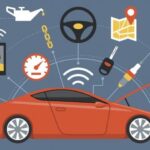Slide 1. Introduction.
The class develops the brake-by-wire in electric and hybrid vehicles and its implications for fleet management.
Slide 2. Electronic braking system.
The electronic braking system, known as “brake-by-wire,” replaces hydraulic connections with digital signals, offering faster response, reduced weight, and increased safety.
In a conventional car, the braking system works primarily through a hydraulic circuit that transmits the force exerted by the driver on the pedal to the wheels. When the pedal is pressed, a piston inside the master cylinder presses the brake fluid, which travels through pipes to the brakes on each wheel. In disc brakes, the pads squeeze the disc attached to the wheel, generating friction and reducing speed. In drum brakes, the shoes expand against the inner surface of the drum to slow down the movement.
This system is supported by power brakes, a device that uses engine vacuum to amplify the pressure exerted on the pedal, reducing the effort required by the driver. In addition, most modern cars incorporate electronic systems such as ABS-Antiblock Braking System, which prevents the wheels from locking during sudden braking, and EBD-Electronic Brakeforce Distribution, which adjusts the braking force between the wheels to optimize stability.
- How does the electronic braking system work?.
With the advent of hybrid and, above all, electric cars, braking technology is undergoing a transformation with the electronic braking system, which dispenses with the traditional hydraulic connection between the pedal and the brakes and uses electronic signals to regulate braking. This innovation, previously only found in high-performance premium models, is now becoming widespread in more conventional cars, improving efficiency, lightness, and safety.
Unlike the classic hydraulic system, which transmitted pressure via a fluid, the electronic braking system uses sensors located in the pedal to send electrical signals to a control unit. This calculates the force required and activates the brakes via actuators or electrohydraulic pumps, or fully electromechanical brakes.
Although the feel of the brake is maintained thanks to simulation mechanisms, such as a motor or spring that provides feedback to the driver's foot, electronic control allows the brake to be modulated precisely and quickly, adapting to various conditions without compromising the driving experience.
The system reduces weight and installation space by eliminating the need for traditional hydraulic components such as hoses, brake fluid reservoirs, brake cylinders, and control units.
For electric vehicle manufacturers, this is a major advantage, as lightweight design is essential for maximizing range. By reducing the weight of the braking system by an average of four kilograms, energy efficiency is improved and electric cars can travel longer distances on a single charge.
Another benefit for the environment is the reduction in the use of brake fluid, which is highly corrosive and difficult to recycle or dispose of in an environmentally friendly manner.
- Advantages of the electronic braking system.
-
- Greater safety and speed.
By centralizing control in microprocessors, assistance systems such as ABS, emergency braking, and stability control are better integrated.
-
- Weight and space savings.
By eliminating bulky components such as the vacuum pump or servo converter, a lighter and more efficient architecture is achieved.
-
- Compatibility with regenerative braking.
In electric cars, it facilitates a smooth transition between regenerative and friction braking.
-
- Greater design freedom.
By eliminating the mechanical connection, braking system components can be located in strategic areas to improve safety and reduce noise, vibration, and harshness.
-
- Safe and efficient braking.
In the event of a failure, each actuator can independently generate the necessary braking pressure on all four wheels, ensuring system redundancy and reliability.
-
- Adaptability for autonomous vehicles.
This technology meets the safety requirements for advanced levels of driving automation.
The electronic braking system is not only revolutionary for passenger vehicles, but also opens the door to its application in public transport, freight trucks, and industrial fleets, where weight reduction and simplified maintenance can have a significant impact on energy efficiency and sustainability.
- What happens in the event of failure.
The idea of eliminating physical connections may seem risky, but current systems incorporate redundancy. For example, in the event of total failure, many vehicles retain a minimum hydraulic connection that allows the driver to brake using the pedal.
The Bosch electronic braking system incorporates two independent hydraulic actuators: a cable actuator and an electronic stability program (ESP) actuator. This configuration eliminates the mechanical redundancy found in conventional braking systems, where there can be failures in the connection between the pedal and the braking system.
In the event of a system failure, both the ESP and the cable actuator can increase the braking pressure on all four wheels independently. This ensures a higher level of safety and reliability that is essential for the adoption of autonomous vehicles.
Bosch has already received orders from several car manufacturers and plans to launch its electronic braking system on the market in fall 2025. Furthermore, it is estimated that by 2030 more than 5.5 million vehicles worldwide will be equipped with this innovative technology.
- Challenges of the electronic braking system.
However, there are challenges: in 2025, Volvo issued a warning about sudden failures in the electronic braking system module of some electric and hybrid models, highlighting the need for robust software and hardware.
Toyota implemented the ECB-Electronically Controlled Brake system in its hybrid vehicles in the early 2000s. It was first introduced in the Estima Hybrid in 2001 and later in the Lexus RX 400h in the US, integrating it with dynamic vehicle control systems.
Since then, many brands have adopted it, including Toyota, Lexus, Ford, GM, Audi e-tron, Porsche Taycan, Alfa Romeo Giulia and Stelvio, and models such as the Corvette C8.
Manufacturers are moving towards the FBS-Future Brake System, such as Continental with its MK C1 architecture in the Alfa Romeo Giulia and Stelvio. In 2025, they will launch a more compact design that will integrate the pump, ABS, and ESC into a single module, freeing up space and simplifying the structure.
The electronic braking system is emerging as a crucial component in the evolution of electric and hybrid cars, as it offers advantages in terms of safety, design, and energy efficiency. Although it requires solid engineering and robust safety regulations, its expansion seems inevitable on the road to cleaner, smarter, and more connected driving.
- Implications for fleet management.
The main consequence is the problems and incidents that can occur due to a lack of knowledge about this technology.
The following measures are recommended.
-
- Driver training.
Drivers must be trained on this technology, how it works, how to drive the vehicle, how to brake, and, very importantly, how to act in the event of a malfunction or if the vehicle loses braking power.
If the vehicle loses braking power, it must be stopped and a tow truck used to take it to our workshop or an external workshop.
Training must be provided on the feel of the brake and how braking works with this type of brake.
-
- Training for mechanics.
Our workshop mechanics must be trained in this technology, possible faults, and repairs.
If our workshop mechanics do not know how to repair the electronic braking system, the vehicle will have to be taken to an authorized repair shop, with the vehicle out of service during that time.
-
- Vehicle purchase.
Before purchasing the vehicle, we need to know if it has an electronic braking system so that we can prepare training for drivers and our mechanics, or decide not to purchase vehicles with this braking technology.
-
- Authorized repair shop.
As this is such a new technology, it is likely that only the vehicle manufacturer's authorized repair shop will have the knowledge to repair it, and the vehicle cannot be taken to another external repair shop.
In summary, the electronic braking system represents a milestone in the evolution of sustainable mobility. Its innovative design reduces vehicle weight, optimizes space, improves safety, and increases energy efficiency, making it a key technology for the future of electric and autonomous vehicles. This system has the potential to transform the automotive industry and accelerate the transition to greener and more efficient transportation.
Slide 3. Thank you for your time.
The class has developed the brake-by-wire in electric and hybrid vehicles and its implications for fleet management, see you soon.




















